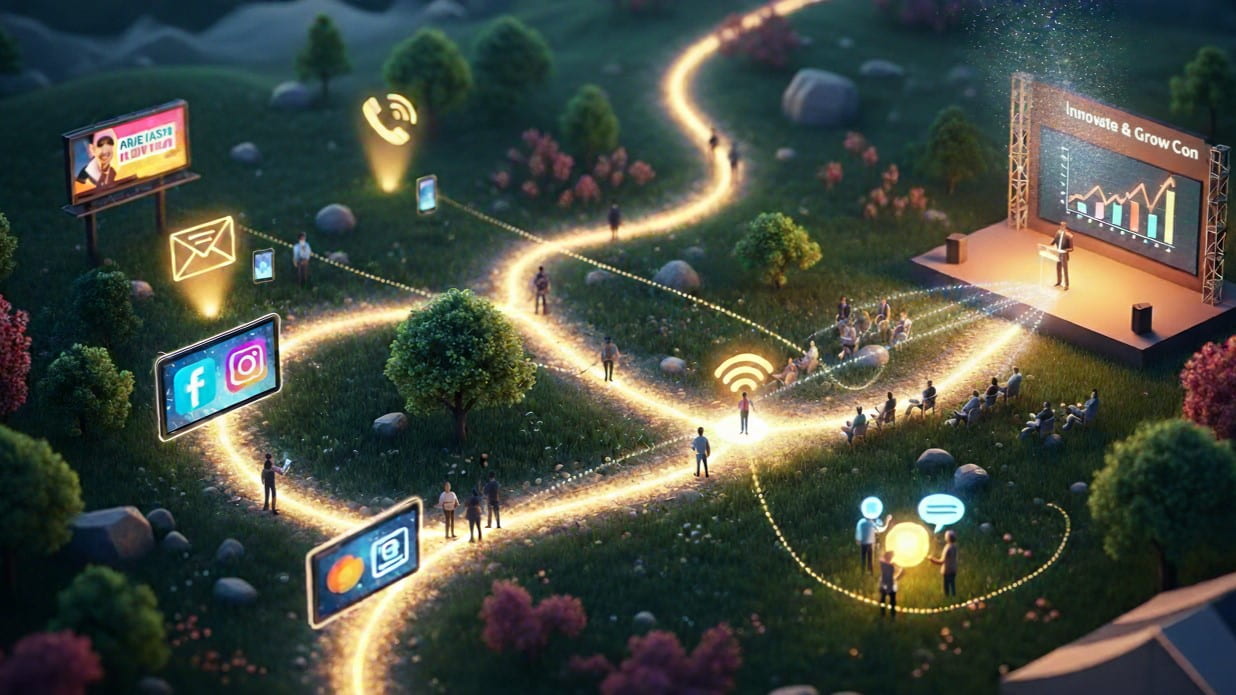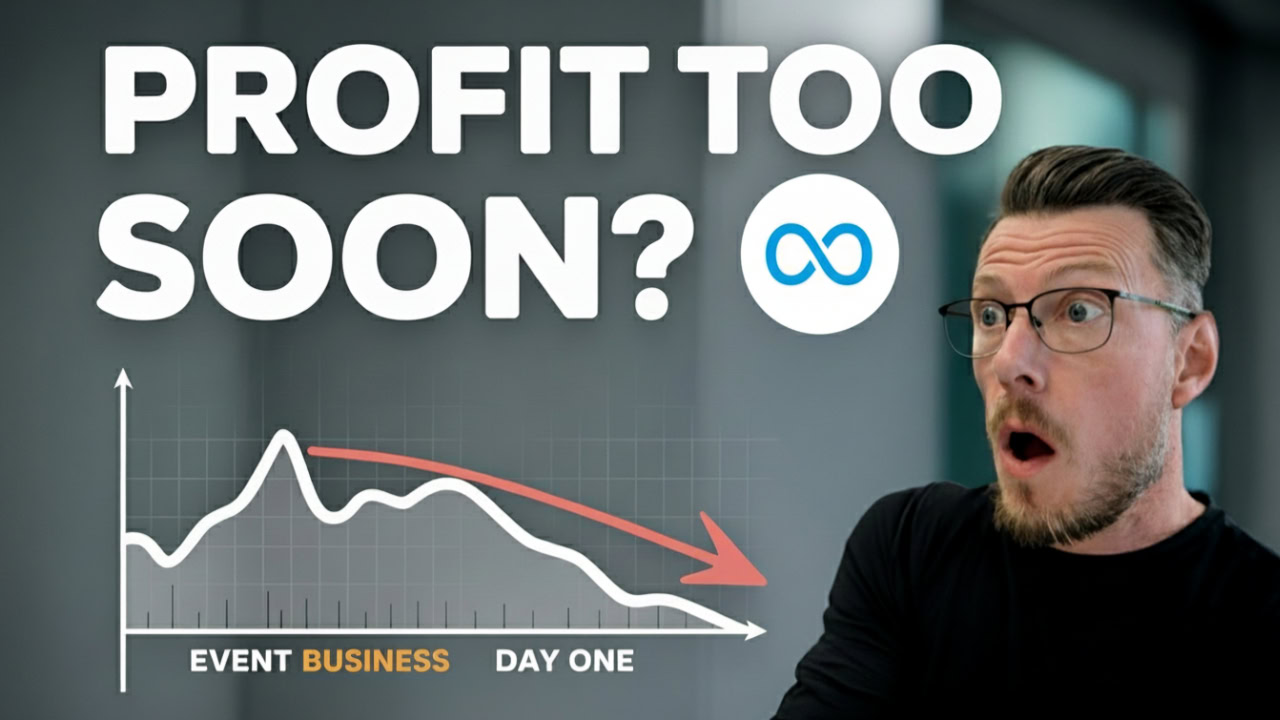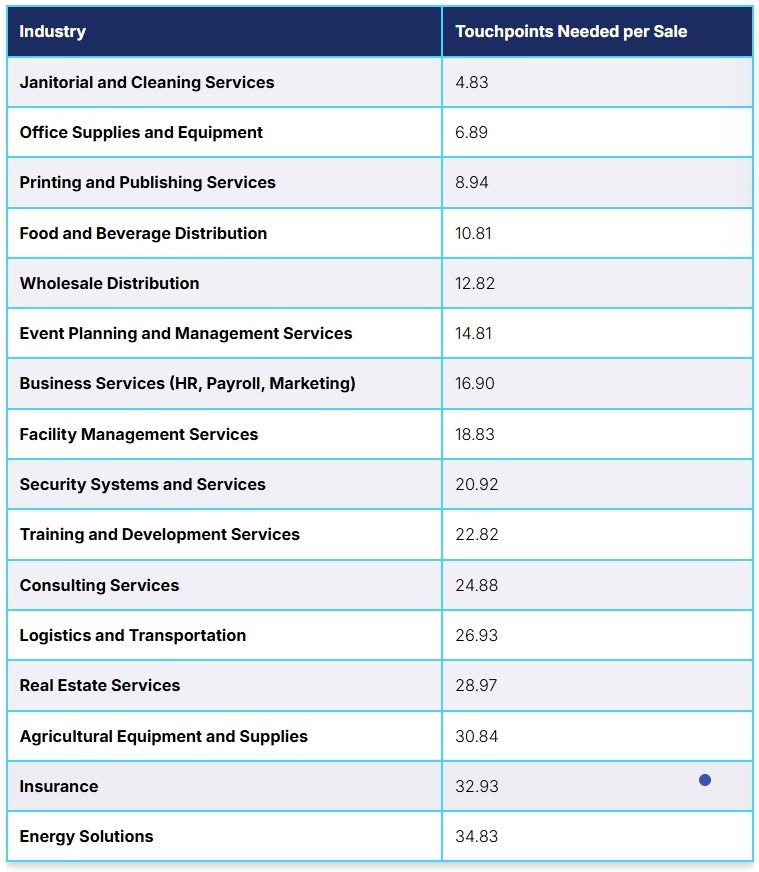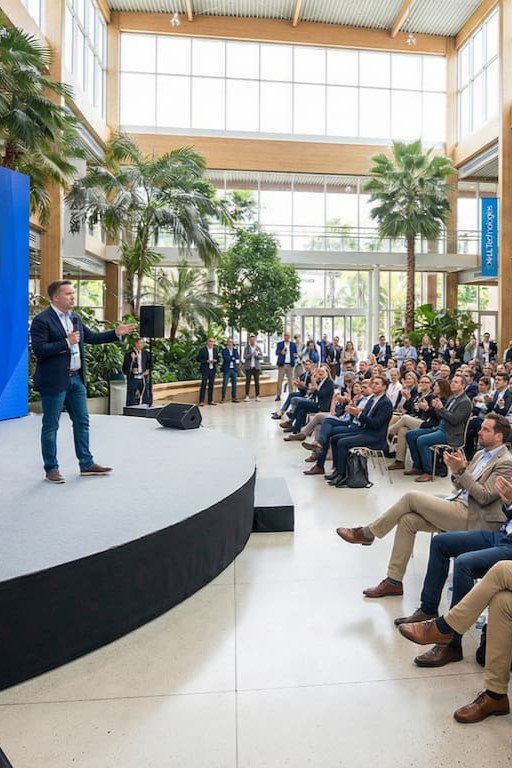Dan Charles
09/09/2025
Table of Contents

Key Takeaways
- Event marketing requires 14.8 touchpoints on average – more complex than commodity services but less than heavily regulated industries like insurance
- Most event companies miss 70% of their marketing value by using last-touch attribution or no attribution tracking at all
- W-shaped attribution model allocates 30% credit each to first touch, lead creation, and opportunity creation, with 10% to supporting touchpoints
- Systematic touchpoint orchestration across digital content, direct engagement, social proof, and educational resources creates competitive advantage over random marketing efforts
- Proper first-party tracking and multi-touch attribution enables optimization for long-term client relationships rather than just immediate conversions
I watched an audio-visual company burn £4,500 on Google Ads without generating a single lead.
They targeted corporate clients the same way they’d approach small businesses. One ad, one touchpoint, expecting immediate conversion.
The math was brutal. Where they’d spend £1,000 to acquire a small business client, corporate prospects cost them six to eight times more. Sometimes they got zero results despite massive ad spend.
This is the attribution crisis hiding in plain sight across the events industry.
The 14.8 Touchpoint Reality
Converting an event prospect takes an average of 14.8 touchpoints.
Image & Data Courtesy of Focus Digital
Most event professionals either give all credit to the last interaction or track nothing at all. Both approaches miss roughly 70% of their marketing value.
The events industry sits in a unique position. We’re not selling commodity services that convert in two or three touches. We’re also not in heavily regulated industries like finance where prospects might need 50+ interactions before making decisions.
Event services require considered investment. Clients are trusting us with their reputation, their budget, and often their career success.
When financial institutions plan six and seven-figure events, they need extensive proof that we understand their requirements. They want case studies, testimonials, detailed portfolios, and multiple conversations before moving forward.
Each of these interactions represents a touchpoint in their decision journey.
Why Traditional Attribution Models Fail Events
The biggest mistake I see is event companies trying to be everything to everyone.
It’s like dropping a pebble in the ocean and hoping the ripples will surface a whale. You need to go fishing in a pond instead.
When you speak to everyone, your messaging becomes generic. Your content addresses surface-level concerns rather than the specific pain points that keep your ideal clients awake at night.
Generic messaging means each touchpoint carries less weight. You need more interactions to build the same level of trust and credibility.
The inverse is also true. The more specifically you speak to your ideal client persona, the more each touchpoint resonates. Sales become easier. Marketing performs better. Lifetime value increases.
But here’s where attribution becomes critical. If you can’t measure which touchpoints drive results, you can’t optimize this process.
The Attribution Gap in Action
Last-touch attribution gives all credit to the final interaction before conversion. Usually a phone call or email inquiry.
This model completely ignores the 13.8 touchpoints that preceded it. The blog post that first introduced your company. The LinkedIn content that built credibility. The case study that addressed specific concerns. The webinar that demonstrated expertise.
No-attribution models are even worse. Event companies run campaigns, see leads come in, and assume correlation equals causation.
I’ve seen clients turn off advertising campaigns because dashboard metrics looked disappointing. Three to six months later, their pipeline dried up. The ads they’d canceled were actually driving significant long-term value.
The challenge is that event sales cycles often span three, six, or nine months. Someone might discover your company in January and become a client in September.
Without proper tracking, you’re flying blind through this entire journey.
The W-Shaped Attribution Solution
The W-shaped attribution model allocates value across the customer journey more accurately.
- Thirty percent of credit goes to first touch. This is where awareness begins.
- Thirty percent goes to lead creation. The moment someone raises their hand and expresses interest.
- Thirty percent goes to opportunity creation. When a qualified prospect enters your sales process.
- The remaining ten percent distributes across supporting touchpoints throughout the journey.
This model recognizes that multiple interactions drive conversions. It helps you understand which channels and content types contribute most to revenue.
For event companies, this means properly valuing the content that builds long-term relationships rather than just measuring immediate responses.
Building Systematic Touchpoint Orchestration
I don’t think in terms of traditional funnels anymore. It’s really about journey mapping.
The goal is creating omnipresence across multiple channels. One well-researched blog post becomes five to ten social posts. You create a video version for YouTube. You develop presentations and visuals that other brands might feature.
Then you promote this content across all channels using paid advertising to amplify awareness.
When the right people start engaging, you make softer asks. Lead magnets. Valuable resources. Content that continues building trust.
Once they’re in your database, you can send testimonials, case studies, and additional proof points that address specific concerns.
Only then do you ask engaged, interested prospects if they want to have a conversation.
This value-first approach raises all ships with the tide. More ideal clients surface and want conversations because you’ve demonstrated understanding of their specific challenges.
The 14.8 Touchpoints Event Companies Can Deploy
Event professionals have a unique advantage in creating meaningful touchpoints because the industry naturally produces visual, engaging content.
Here are the specific touchpoints that make up your 14.8 touchpoint journey:
Digital Content Touchpoints:
- Blog posts addressing industry-specific challenges
- Case studies showcasing similar events
- Video testimonials from past clients
- Behind-the-scenes event footage
- LinkedIn articles and posts
- Instagram stories and reels
- YouTube channel content
- Email newsletter campaigns
- Downloadable planning guides and checklists
Direct Engagement Touchpoints:
- Initial discovery calls
- Venue site visits
- Proposal presentations
- Follow-up phone calls
- Email responses to questions
- Contract negotiation meetings
- Planning check-in calls
- Post-event debrief sessions
Social Proof Touchpoints:
- Online portfolio galleries
- Client testimonial pages
- Award recognitions and certifications
- Industry publication features
- Speaking engagements at conferences
- Vendor and venue partnerships
- Google reviews and ratings
Educational Touchpoints:
- Webinars on event trends
- Industry report downloads
- Planning templates and resources
- Budget calculators
- Venue comparison guides
- Timeline planning tools
Each touchpoint serves a specific purpose in building trust and demonstrating expertise. Early touchpoints focus on awareness and education. Middle touchpoints address specific concerns and showcase capabilities. Later touchpoints handle objections and facilitate decision-making.
The key is orchestrating these touchpoints systematically rather than hoping prospects stumble across them randomly.
The Technical Infrastructure Required
Proper attribution requires detailed first-party tracking that integrates with your website, social channels, ad platforms, CRM, and phone systems.
This allows you to measure interactions between different touchpoints and model them using multi-touch attribution.
You can track signals of intent and measure how many convert into genuine business interest. Then you can see how much of that interest becomes actual opportunities.
The setup requires patience. If your sales cycle runs three to nine months, you might wait that long before seeing complete data sets.
But the insights are worth it. You’ll discover which content drives long-term value even if it doesn’t generate immediate responses. You’ll identify which channels contribute to deals that close months later.
Most importantly, you’ll stop making decisions based on incomplete information.
Why This Creates Competitive Advantage
While your competitors focus on last-touch metrics or gut feelings, you’re optimizing the entire customer journey.
You understand which early-stage touchpoints drive the highest lifetime value clients. You can invest more in channels that contribute to long-term relationships rather than just immediate leads.
This knowledge justifies premium pricing. When you can demonstrate systematic approaches to client acquisition and relationship building, prospects understand they’re investing in proven processes rather than hoping for good results.
The events industry thrives on long-term relationships. Clients who have positive experiences stick around for years. They refer other opportunities. They increase project scope over time.
Understanding the full 14.8 touchpoint journey helps you optimize for these valuable, long-term relationships rather than just quick conversions.
Implementation Framework
Start by getting ruthlessly specific about your ideal client persona. The more narrowly you can define your target market, the more each touchpoint will resonate.
Map out the natural topics, questions, and content types that appeal to this specific audience. Create comprehensive content that addresses their concerns throughout the decision journey.
Implement tracking systems that capture interactions across all channels. Website visits, social engagement, email opens, ad clicks, phone calls, meeting requests.
Use this data to identify which touchpoints contribute most to your highest-value clients. Double down on channels and content types that drive results.
Be patient. Attribution data becomes more valuable over time as you accumulate larger sample sizes and longer tracking periods.
Most event companies will never do this work. They’ll continue making decisions based on incomplete information, wondering why their marketing feels inconsistent or expensive.
The Long-Term Advantage
Event professionals are naturally creative. You excel at producing content, case studies, portfolios, testimonials, presentations, and visual materials.
The missing piece is systematic measurement and optimization of how these assets work together across the customer journey.
When you can demonstrate ROI from your marketing efforts with precision, you gain confidence to invest in channels that drive long-term value.
You stop second-guessing decisions based on short-term metrics that don’t tell the complete story.
You build sustainable competitive advantages because you understand your business at a deeper level than competitors who are still flying blind.
The 14.8 touchpoint reality isn’t going away. B2B decision-making continues becoming more complex, not simpler.
Event companies that master attribution now will have significant advantages as the industry evolves. They’ll make smarter investment decisions, optimize for higher lifetime value clients, and build more predictable revenue streams.
The question is whether you’ll be among them or continue measuring success the way everyone else does.
Event companies that master attribution now will have significant advantages as the industry evolves. They’ll make smarter investment decisions, optimize for higher lifetime value clients, and build more predictable revenue streams.
The question is whether you’ll be among them or continue measuring success the way everyone else does.

Why Your Event Business Doesn’t Need More Martech: It Needs a Coherent Message

Universal Attribution for Event Businesses: Track Every Lead Across Any Form Tool

The 4-Phase Event Marketing Timeline System: From Reactive Panic to Predictable Revenue





